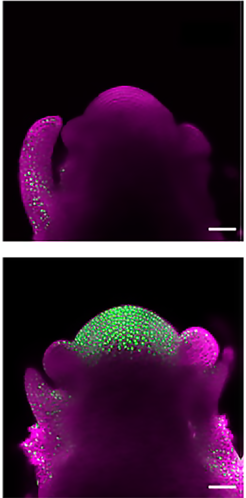MICRORNA genes that promote flowering of Arabidopsis
MicroRNAs are short RNA molecules that play an important role in regulating the expression of genes in animals and plants by either degrading gene transcripts or blocking their translation. Plant genomes encode many different microRNAs and each one is expressed by several MICRORNA genes. These genes are differentially expressed in different tissues and developmental stages. Scientists at the Max-Planck Institute for Plant Breeding Research in Cologne have used gene editing approaches in Thale cress (Arabidopsis thaliana) to show how individual members of the MIR172 gene family promote flowering by reducing the expression of a protein that delays flowering and is expressed at the shoot apex.
The model plant species Arabidopsis thaliana contains five MIR172 genes, named MIR172A to MIR172E. This family of genes promotes flowering by reducing expression of APETALA 2 (AP2) and AP2-LIKE proteins, DNA-binding transcription factors that repress flowering. To date, knowledge of the individual contributions of the five different MIRNA172 genes to floral transition has been limited because loss-of-function mutations in each of them were not available, and because they have similar functions, which means that they can functionally substitute for each other when expressed in the same cells.
Diarmuid Ó’Maoiléidigh and coworkers from the laboratory of George Coupland visualized the expression of fluorescent-tagged versions of all the full-length MIR172 genes with confocal microscopy and showed that MIR172A, MIR172B, and MIR172D are expressed in the shoot apex around the time of the floral transition. The researchers then individually knocked-out the function of all five MIRNA172 genes by inducing mutations with CRISPR/Cas9 mediated gene editing. The detailed analysis of the time at which these single and higher-order mutants flowered, together with their expression patterns, demonstrated that the role of miR172 is critical in promoting flowering, particularly under short-day conditions. Additional confocal imaging of AP2 expression in the wild-type and mir172abd triple mutant showed that these MIR172 genes promote flowering by reducing the level of AP2 protein in the shoot apex

Confocal images of Arabidopsis apices showing APETALA2 protein (green) in wild type (top), and in a mir172abd mutant (bottom), growing in long days. MIR172 genes are required to reduce the AP2 level.
Many other proteins are known to promote flowering in Arabidopsis and these include two other DNA-binding transcription factors called FUL and SPL15. FUL also promotes flowering by directly repressing the amount of AP2 protein, and the researchers showed genetically that under short-day conditions, this occurs in a parallel but additive way to the reduction in AP2 expression by the MIR172 genes. They also showed that the FUL gene and the MIR172 genes are activated by SPL15. Therefore, SPL15 promotes flowering of Arabidopsis by activating FUL and MIR172, which in turn, repress AP2 and AP2-like genes. The study contributes to understanding the complex regulatory logic required to provide a rapid and robust transition from vegetative development to flowering in different environmental conditions. Furthermore, a second article from the Coupland group recently used sophisticated 2.5D imaging techniques based on confocal microscopy images to decipher how increases in cell size and division rate contribute to morphological changes in shape of the shoot apex, called meristem doming, during the floral transition (Kinoshita, Vayssières et al 2020 eLife). Therefore, future experiments will focus on bringing together these two advances to understand how the miR172/AP2 module contributes to changes in cell behaviour and meristem shape during floral transition.
